Audiogyan
Audiogyan is a collection of wide-ranging conversations with designers, artists, musicians, writers, thinkers, and luminaries of the Indian creative world. Started in 2016 by Kedar Nimkar, the podcast hopes to expand the definition of design, document, archive, and inspire fellow generation artists.
Episodes
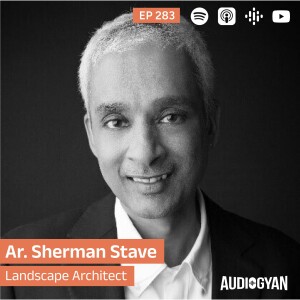
Wednesday Oct 18, 2023
Wednesday Oct 18, 2023
In late 1800s, A Spanish architect, Antonio Gaudi, said, “There are no straight lines or sharp corners in nature. Therefore, buildings must have no straight lines or sharp corners”. But where does the nature stop and where does the building begin? Lets explore more about architecture and history in this 3 part series called, “An insert into the history”.
This series is brought to you by, The Drawing Board, with whom I had partnered last year. The Drawing Board is an international architecture platform based in India. TDB has been actively running Architecture competition for under graduate students since 2016. It is conceptualised by Mindspace Architects and Rohan Builders.
This year, the program is to redesign the existing Badami archaeological museum, in Karnataka. Submission deadline is 9th Oct 2023. More details on thedrawingboard.in
Today, in this concluding episode of this series, we have Ar. Sherman Stave with us on Audiogyan. Sherman is a Principal and Landscape Architect at STX Landscape Architects. With more than 30 years of experience. He has practised extensively in Asia and North America. His exposure to diverse cultures from an early age has lent him broad global perspective, and a deep appreciation of how shaping our environments can change our lives in fundamental ways. These are critical lenses that continue to inform his design approach.
Questions
Who is a landscape architect? What are the principles and strategies on which a landscape architect work?
BV Doshi, once said, “Is the Architecture defined by theory or it’s a convention, or it is something which is rooted in the place?” How big or small overlap do you see between the landscape and the actual building or architecture? Incase of Badami, where and how would you draw the line?
Brian O’Doherty’s famous line, “We have now reached a point where we see not the art but the space first.” What does it mean and where are you on this?
How can landscape design contribute to the interpretation and visitor experience at any archaeological site? For instance, Badami, where the landscape itself is an integral part of the site's history?
What considerations can be taken while designing architecture in such high sensitive historical landscape? When designing an archaeological site like Badami to ensure minimal impact?
Since you are staying in Singapore and even I have recently moved there, I see some amazing work done by humans. The overall landscape is well thought. Can you share your learnings and experience? How can we be so close to nature yet seems to have so much command on it?
Can you share any (2) examples of good museums or public spaces where they blend organically with nature?
Reference reading
The Drawing Board Architecture competition for Undergradute student 2024
Talk by Prashanth Pole | 27 Mar, 2021 | FA S21 Lecture series
Gandhi Ashram Sabarmati
Don Bosco Centre for Indigenous Cultures
Badami- Learning from the Context- WCFA, Teepoi
Mindspace Architects
Rohan Builders
https://www.siww.com.sg/home/attend/siww2021-online/thematic-webinars-tw/speakers-and-moderators/sherman-stave
https://www.stxla.com/profile/
https://www.world-architects.com/en/stx-landscape-architects-singapore/team
https://www.mnd.gov.sg/urbansustainability/webinars/liveability/abc-water-seminar-(liveability)
https://www.ura.gov.sg/uol/publications/research-resources/plans-reports/Master%20Plan/~/media/User%20Defined/URA%20Online/publications/research-resources/plans-reports/pwip_urban_villages.ashx
https://kimbellart.org/art-architecture/architecture/kahn-building
https://www.salk.edu/
https://www.archdaily.com/61288/ad-classics-salk-institute-louis-kahn
https://www.designcurial.com/news/louis-kahn---six-most-important-buildings-4323752/
https://en.wikipedia.org/wiki/Louis_Kahn
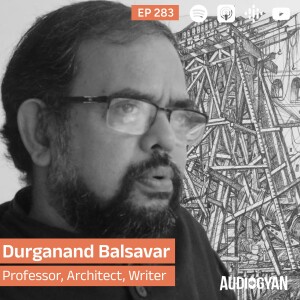
Wednesday Oct 11, 2023
Wednesday Oct 11, 2023
Frank Owen Gehry, a Canadian-born American architect and designer once said, “Architecture should speak of its time and place, but yearn for timelessness”. How can we long for timelessness in architecture if the place itself keeps changing? Lets explore more about architecture and history in this 3 part series called, “An insert into the history”.
This series is brought to you by, The Drawing Board, with whom I had partnered last year. The Drawing Board is an international architecture platform based in India. TDB has been actively running Architecture competition for under graduate students since 2016. It is conceptualised by Mindspace Architects and Rohan Builders.
This year, the program is to redesign the existing Badami archaeological museum, in Karnataka. Submission deadline is 9th Oct 2023. More details on thedrawingboard.in
In this second episode, “An insert into the history” (which is also the theme of the competition), I have a Prof. Durganand Balsavar. I interviewed him back in episode 249 in the last year’s TDB theme of designing a “Memorial for Charles Correa”. We spoke about intangible architecture.
A quick introduction about Prof. Balsavar. He has been faculty for India Studios of Bartlett, Helsinki School of Architecture and involved in diverse cultural contexts - the Chandigarh Lab, IUAV Venice, Auckland, Indonesia, Nepal. He founded Artes-ROOTS Collaborative, which has been involved in an environment-appropriate architecture as a community participatory process.
Questions
If we look at Indian history and culture, how can one incorporate architectural elements that reflect diverse narratives in a museum projects? What can be the key principles on which this can be thought?
History is told by the rulers. I believe you also have a special interest in Alternate Histories - What does it mean?
So, If alternative histories often involve revisiting and reinterpreting established narratives. How does your architectural design support the reinterpretation of history within the museum context?
Can you share your thoughts on the role of technology, such as interactive exhibits or virtual reality, in enhancing the visitor experience and storytelling within museums dedicated to archaeology and alternate histories?
Can you share any unique architectural features or design elements that distinguish the Badami Archaeological Museum from other museums with similar themes?
Badami is known for its cave temples and rock-cut architecture. What elements can be incorporated in storytelling and educational experiences? How do you see that helping the narrative of the museum in the modern world?
Since the topic is, An insert into History, and your strong opinions on sustainability, What role does sustainability play in the design of the Badami Archaeological Museum, and how do you incorporate those elements into the architecture?
Can you share any other museums you have studied or been part of that are worth studying and referenced? Nationally or internationally?
Reference reading
The Drawing Board
Rohan Builders
Mindspace Architects
Charles Correa
Charles Correa Foundation
Culture Trip
Down to Earth
Durganand Balsavar
Artesroots
Duganand on Linkedin

Wednesday Oct 04, 2023
Wednesday Oct 04, 2023
BV. Doshi, once said, “A house is a grain, like a small sapling in the bio-diverse wild forest”. I wonder what a public space like a temple, a monument, museum, a park, an industrial zone, a 80 floor office tower or a man made landscape is? Lets explore more about architecture and history in this 3 part series called, “An insert into the history”.
This series is brought to you by, The Drawing Board, with whom I had partnered last year. The Drawing Board is an international architecture platform based in India where students can test their understanding and skills in shaping the way communities live and thrive while preserving local heritage. TDB has been actively running Architecture competition for under graduate students since 2016. It is conceptualised by Mindspace Architects and Rohan Builders.
This year, the theme is to redesign the existing Badami archaeological museum, in Karnataka. Submission deadline is 9th Oct 2023. More details in the show notes and thedrawingboard.in
We begin this series with Ar. Prashant Pole. Prashant has a long and illustrious career that has spanned over three decades. His journey started with Naksha Architects in Bengaluru. He established his own firm, Genesis Architects in 1994 and has worked on single residences, apartments, offices, hotels and institutional buildings. Over these years, he has also been a visiting faculty at MCE Hassan, BIT Bangalore, SIT Tumkur, and USD Mysore. Aside from teaching, he has also been evaluating architecture design as a juror at various architecture schools in and around Bengaluru. We’ll be discussing what goes into making a museum.
Questions
What is the museum according to you? Why do we need them?
Are there any special characteristics when it comes to Museum’s architecture? How can we optimise space to accommodate a wide range of exhibits while maintaining a seamless visitor experience? (Considering people coming from diverse background, language, ethnicity, abilities and more)
Accessibility, sustainability, security, are few common and must have things for any architecture, what are few other guidelines when it comes to a place like Museum?
Which are the famous museums in India and why?
Since this year’s theme is redesign the existing Badami archaeological museum, how can we approach integrating the cultural diversity and historical significance of Badami into the design of a museum, ensuring it resonates with both local and international visitors?
We say that “any place to be built should be built with the material found in 5KMs or it’s radius”. How true is it and why? How do you leverage local materials and craftsmanship to create a distinctive architectural identity for the museum, and what challenges might arise in this context?
Lighting and climate control are crucial factors in preserving the artifacts. How can we go about creating and ideal environment yet ensuring it’s sustainable? We can consider Badami or any other museum (located in the such setup in India)
What suggestions would you give those who wish to specialise in designing museums? Any extra attention in the context of Bandami museum?
Reference reading
https://wcfa.ac.in/staff/prashant-girish-pole/
https://www.youtube.com/watch?v=cj84z3FA0tU
https://thedrawingboard.in
https://thinkmatter.in/2020/09/15/an-ephemeral-lab-in-a-city-of-fixity/
https://www.bmsca.org/workshops.html
https://www.gandhiashramsabarmati.org/en/
https://www.youtube.com/watch?v=a_U9rjdsmOg
https://dbcic.org
The Drawing Board
Rohan Builders
Mindspace Architects
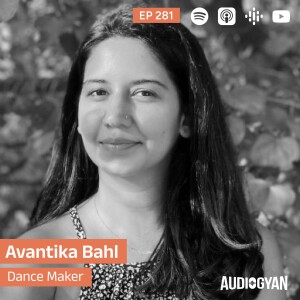
Wednesday Sep 20, 2023
Wednesday Sep 20, 2023
Friedrich Nietzsche’s famous line - “And those who were seen dancing were thought to be insane by those who could not hear the music.”
In today’s episode, we’ll be talking about improvisation in dance with Avantika Bahl. Avantika is a dance practitioner and educator based in Mumbai. As an artist, she works towards creating inclusive performances that can be accessed by a larger community. Over the past few years, her choreographic choices have brought diverse voices and experiences to the mainstream. She studied at the London Contemporary Dance School and completed the Curriculum-in-Motion program offered by Jacobs Pillow. Avantika has a Masters degree in English Literature and completed her Level 3 certification in Indian Sign language.
Questions
What according to you is improvisation? Where do we see it mostly happening? Is it seen in all creative endeavours?
You have dabbled with silence, mundane chores, sometimes with just burst of sounds. What do you call your form of dance? Which category / genre does it belong?
What does it mean to improvise in the context of dance? What guides improvisation for you - Body, Music, Theme, Story, Location or anything else?
Traditionally dance (or most performing art forms) were considered to be performed effortlessly (Sahaj) and elegantly (simple). Does one need to know the rules to bend the rules? What does bending a rule mean? Improvisation?
Your show “Say, What?” with a creative partner who is deaf. What is the extent of improvisation that a dancer can explore and still make it palatable? What the biggest challenge in experiments like these? You said, “We just have to be still and dance” - What do you mean?
Tell us about your experience learning the Indian Sign language. How did it help?
When and why do dancers improvise? When we fail or when we do something over and over again? Is it the boredom? Is it uncovering deeper layers as they keep performing or revisiting the movements? Is it that the medium falls short to express?
Can improvisation be a starting point? Do smaller improvisations impulses land in changing the meta narrative? How does one come back to the main kathavastu / main narrative? May be you can explain in the context of “Look left, turn right”?
What is the extent of improvisation when it comes to dance? Can you share any examples - names and artists who are doing and have done a lot in the past?
What according to you is the future of dance and improvisation?
Reference reading
https://www.avantikabahl.com
https://www.instagram.com/avantikabahl/?hl=en
https://prakritifoundation.com/artiseprofile/avantikabahl/
https://vimeo.com/user5724048
https://www.themovementartsco.com/blank-page
https://narthaki.com/info/rev17/rev2058.html
https://theideaslab.com/say-duet-celebrating-sounds-silence-movement/
https://en.wikipedia.org/wiki/Merce_Cunningham
https://www.theguardian.com/stage/2006/sep/16/dance
https://sites.northwestern.edu/cageanddance/jcchoreo/
https://www.abt.org/people/john-cage/
https://en.wikipedia.org/wiki/John_Cage
https://studsterkel.wfmt.com/programs/merce-cunningham-and-john-cage-discuss-music-and-dance
https://en.wikipedia.org/wiki/Ohad_Naharin
https://www.dansedanse.ca/en/ohad-naharin
https://www.gagapeople.com/en/
https://www.nytimes.com/2023/03/02/arts/dance/review-ohad-naharin-hora-batsheva.html
https://www.newyorker.com/culture/culture-desk/the-secret-history-of-the-israeli-choreographer-ohad-naharin
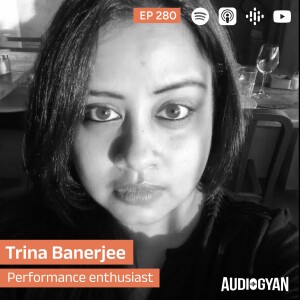
Wednesday Sep 13, 2023
Wednesday Sep 13, 2023
Satyajit Ray once said, “There is always room for improvisation”. I think this needs a lot more investigation.
Referring to Ray’s comment on the room of improvisation, today we have the honour to have Dr Trina Banerjee with us on Audiogyan. We’ll talk about improvisation in the context of Theatre, Plays, Playwriting, and performing arts at large.
Trina is an Assistant Professor in Cultural Studies at the Centre for Studies in Social Sciences, Calcutta. Her research interests include Gender, Performance, Political Theatre, Theories of the Body, Postcolonial Theatre and South Asian History. She has also been a theatre and film actress, as well as a journalist and fiction writer.
Questions
What according to you is improvisation? In how many ways do you see it manifesting? Where do we see it mostly happening? On streets? In life? or just creative endeavours?
When do people improvise? What’s the motivation? Is it expressing themselves in different ways? Is it to communicate better with the other (State, society, individual)? Why do they do? Can you give any examples?
What does it mean to improvise in the context of performing arts (Theatre, Dance, and more)?
Are there categories or genres of improvisation which can be studied systematically? Did different forms of Theatre like the Theatre of Absurd or Pantomime and more emerge due to improvisation?
When and why do people improvise on stage? When do we fail or when do we do something over and over again? Is it the boredom? Is it uncovering deeper layers as they keep performing or revisiting the text?
When and how do improvisations become part of the main setup? As in, no longer be called improvisations? Has it happened that the playwright made changes to the original text as the years passed by?
Reference reading
https://www.cssscal.org/faculty_trina_nileena_banerjee.php
https://www.instagram.com/trinanileena/
https://www.youtube.com/watch?v=OtYA-zEkMjI
https://www.youtube.com/watch?v=Ti-bOIuUrwM
https://www.youtube.com/watch?v=eArQSc9KDKo
https://www.youtube.com/watch?v=T53FQ-m74Xg
https://www.youtube.com/watch?v=DmPiN2Tp3W0
https://www.youtube.com/watch?v=oi-owRniSBM
https://www.youtube.com/watch?v=5lX2_2cV9lY
https://www.amazon.in/Books-Trina-Nileena-Banerjee/s?rh=n%3A976389031%2Cp_27%3ATrina+Nileena+Banerjee
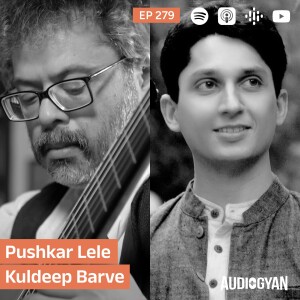
Wednesday Sep 06, 2023
Wednesday Sep 06, 2023
I quote John McLaughlin “I find Indian music very funky. I mean it's very soulful, with their own kind of blues. But it's the only other school on the planet that develops improvisation to the high degree that you find in jazz music. So we have a lot of common ground.”
Pushkar Lele and Kuldeep Barve joins us on Audiogyan and we will be talking about “Improvisation in music”. It’s going to be a bi-lingual conversation in English and Marathi.
Pushkar is a renowned Hindustani classical vocalist and Founder-Director of ‘Gandhara School of Music’. More about his Gurus, rich repertoire and enriching journey of learning music in the show notes.
Kuldeep is a classical guitarist. His practice is influenced by jazz and Indian classical music. He is a co-founder and a core member of the Pune Guitar Society.
Welcome Pushkar & Kuldeep! It’s an honor to have you on Audiogyan. Thanks for giving your time.
As I started of with John McLaughlin’s quote, I wanted to document some of your thoughts on “Improvisation” - when it comes to Hindustani Classical and Western Classical music with a lot of Jazz which I believe has a lot of improvisation.
Just as a small plug, you can also listen to “Jazz in India” where I interviewed Denzil Smith in episode 133.
Questions
What according to you is improvisation in the broadest sense?
What does it mean to improvise in a concert? When is it required? How spontaneous it is
Do you see a similar pattern in a Western Classical performances? Or perhaps Jazz? Can we confidently say that each performance by Loius Amstrong was different even for the same set of tracks?
Do you need to be qualified to improvise? If yes, when are you allowed to improvise in Guru Shishya Parampara?
Do we have a lineage kind of a thing in Western music as well - which deals with improvisations? Especially in genres like Jazz, Blues or country?
What is the difference between improvising, exploring or presenting with a different perspective?
When do we call something is improvised? After how much deviation from originally planned is called improvisation?
When does one improvise? When they do the same thing over and over again or when they see some room for exploration? What’s a more common pattern?
What are the extents of improvisation? Whats at stake when an artist is improvising?
Can improvisations land in a loop of improvisations? How do you come back to the sthayi bhava?
Does a well trained audience appreciate improvisations?
When and how do improvisations become part of the main setup? As in, no longer be called as improvisations?
Reference readings
https://en.wikipedia.org/wiki/Pushkar_Lele
https://www.facebook.com/lelepushkar/
https://map.sahapedia.org/article/Pushkar-Lele/2912
https://www.youtube.com/@lelepushkar
https://soundcloud.com/pushkar-lele
https://twitter.com/lelepushkar?lang=en
https://map.sahapedia.org/article/Kuldeep-Barve/3004
https://www.instagram.com/kuldeep.barve/?hl=en
https://www.linkedin.com/in/kuldeep-barve-4394514/?originalSubdomain=in
https://puneguitarsociety.org/core-team/
https://twitter.com/mifya?lang=en
https://soundcloud.com/kuldeep-barve
https://www.academia.edu/33995371/Strings_attached_A_short_history_of_the_Western_classical_guitar_in_India_docx
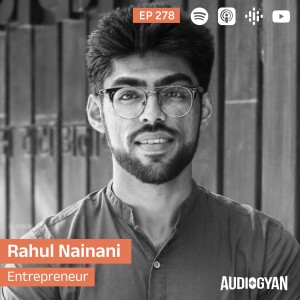
Wednesday Aug 16, 2023
Wednesday Aug 16, 2023
“Waste not, want not.” can be explained as “if you are not wasteful with the resources you have now, then at a later date you will have those resources to use as you want and need. By not wasting, you will not be needy later.”
And today to discuss all about waste ecosystem and the sector at large, we have Rahul Nainani with us on Audiogyan. Rahul has a passion for sustainable policies that create value. With one eye on the bottom line and the other on tangible social impact, Rahul, along with his co-founder Gurashish Singh Sahni founded ReCircle in 2016, as an innovative, multifaceted solution to India’s burgeoning waste management woes. ReCircle has instituted flagship initiatives such as, ClimaOne, Plastic EPR Service, Plastic-Neutral programs and ground-level community collection drives. We’ll talking about this and more.
Questions
How do we define waste? What all broad categories of waste do we generate?
Can you share some stats about waste generated in India every day? Perhaps about the waste ecosystem and the sector at large?
How does the entire setup work? Which all entities are involved in handling waste? From collection at source to finally dumped or put for recycling?
How do we do in comparison to other developing countries like us?
How critical has been the impact of Swatch Bharat and other initiatives to entrepreneurs like you or the entire ecosystem?
Tell us a little bit about ReCircle — how did you come to start it and why? Tell us about your team, initiatives, programs and everything. Right from Safai Saathis to governing bodies, how do you engage with them?
What is ClimaOne? Tell us about other flagship initiatives under ReCircle?
How has technology changed things for everyone in this ecosystem? How and where technology is applied?
Waste management doesn’t sound very sexy. How do you attract talent and run the company?
What is the future of Waste? Can we expect waste in Meta-verse? Can we expect India to be as clean as Singapore?
Reference reading
https://www.linkedin.com/in/rahulnainani
https://www.mwcbarcelona.com/agenda/speaker/rahul-nainani
https://twitter.com/rahul_nainani?lang=en
https://www.instagram.com/rahulnainani18/
https://recircle.in
https://www.theentrepreneursofindia.in/post/rahul-nainani-the-entrepreneurs-of-india-youngpreneur-magazine-august-2022
https://www.linkedin.com/company/recircleindia/?originalSubdomain=in
https://www.eatmy.news/2023/07/rahul-nainani-gurashish-singh-sahni-how.html
https://medium.com/worthwhile/in-conversation-with-rahul-naini-ceo-and-cofounder-of-recircle-52c31f156f41
https://www.linkedin.com/in/gurashish123/?originalSubdomain=in
https://yourstory.com/companies/recircle
https://www.thequint.com/explainers/explained-indias-cleanest-city-indore-is-earning-huge-bucks-from-its-garbage
https://en.wikipedia.org/wiki/List_of_cleanest_cities_in_India
https://theprint.in/india/these-are-the-secrets-to-indores-5-year-cleanest-city-streak-and-its-not-rocket-science/772362/
https://indianexpress.com/article/india/indore-cleanest-city-swachh-rankings-7632466/
https://en.wikipedia.org/wiki/Ambikapur,_Chhattisgarh
https://india.mongabay.com/2023/05/ambikapurs-women-led-waste-management-system-also-generates-revenue-for-the-city/#:~:text=Ambikapur bagged a bigger recognition,best self-sustained small city.
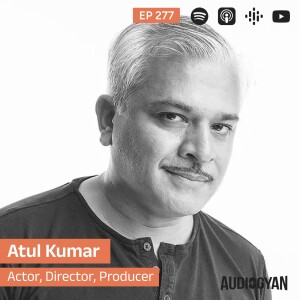
Wednesday Aug 09, 2023
Wednesday Aug 09, 2023
Peter Brook the legendary English theatre and film director once said, ********“I can take any empty space and call it a bare stage. A man walks across this empty space whilst someone else is watching him, and this is all that is needed for an act of theatre to be engaged.”
Lets talk about the need for such a space with Atul Kumar.
Atul Kumar is The Company Theatre’s founder member. An acclaimed actor and director with more than 30 years of performance experience, Atul has dabbled with different languages and forms of theatre & has showcased his work all over India & abroad. His basic performance training was in the traditional Indian dance and martial art forms of Kathakali and Kalerippayettu in Kerala for over three years as well as a stint with the master of visual theatre - Philippe Genty in France. More about him in the show notes. Today we’ll deep dive into The Company Theatre Workspace, Kamshet as a case study.
Questions
What is The Company Theatre Workspace at Kamshet?
What inspired you to make such a place? Was it the influences from Aadishakti, Nrityagram or Footsbarn theatre group?
There is a beautiful 10 minute video on youtube where you briefly explain the backstory of this place and how it came to be. Do you want to share more details like which were the other 3 spots you shortlisted and why chose this over others? Why was your “want to” list huge? What were your pre-requisites?
Why do you call it a laboratory for theatre and performing arts? When I see your Instagram page, artists are doing all sorts of things from Tai Chi, Yoga to just running around and doing theatre drills, packed with high intensity body movements. What do you do in the space?
You mentioned that “we don’t always expect artists to do something specific but just be by themselves”. How does this help? Reflection, introspection anything else?
For outcome oriented projects, people need structure to think, how does this place facilitate it?
(Philosophical) Everyone needs time to pause and reflect. Do artist need more of it? Why? Can you tell us more about the place? How does the place accommodate for experimentation? Geography, topology, open space, residency and other things about the place?
What’s the future? Do we need more such spaces? Do we have similar places in India? Some mentions about your wonderful and dedicated to art team?
Reference links
https://www.instagram.com/atulkumartct/?hl=en
https://twitter.com/atulkumartct
https://www.imdb.com/name/nm1241640/
https://www.thecompanytheatre.net/team
https://www.youtube.com/c/AtulKumarTheCompanyTheatre/videos
https://www.youtube.com/watch?v=bm1h1CY-X1w
https://www.youtube.com/watch?v=aJ6PfJEDOmc
https://www.youtube.com/watch?v=RrKp30jP28o
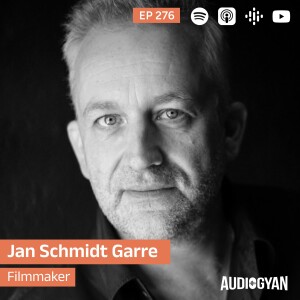
Wednesday Aug 02, 2023
Wednesday Aug 02, 2023
Welcome back to Part 2. We were in conversation with Jan Schmidt Garre, film maker, producer and founder of PARS MEDIA. They make high-quality documentaries and feature films with a focus on classical music, dance, and the fine arts.
In the previous episode, we spoke about “Making a documentary” and in this, we speak about his latest Documentary on Late Ar. B.V.Doshi called the “The Promise – Architect BV Doshi”.
Questions
You have made 2 documentaries in the East. What fascinates you about the East, about India?
What makes you make films of Design, art, dance and such creative expressions. Why did you consider architecture to be part of art as a film maker?
What is “The Promise – Architect BV Doshi”? How did the idea of documenting him come about?
How did you discover Doshi’s and what drew you closer to him?
There has been so much documentation on Doshi. What is your narrative in the film?
In your interview with Ritupriya Basu, you said, “Doshi’s architecture must not be shown silently.” How did you manage to show the interactions between the architecture and their inhabitants?
Whats the most enriching moment during your interaction with the legend and making of the film?
I also happened to interview Doshi on Audiogyan. Every word he says is magical. Very difficult to cut things as they are lyrical and rhythmic. How did you go about editing this film. Seems like the toughest part of the adventure
What was your biggest learning and takeaways from the experience? Can you share any anecdotes or experiences of chatting with him, going on a spiritual journey with so beautiful metaphors and explaining the most complex things with love.
When are you showing the film in India? How can people watch it?
Reference links
https://www.parsmedia.com
https://www.rottentomatoes.com/celebrity/jan_schmidtgarre
https://www.instagram.com/janschmidtgarre/
https://www.delage-artists.com/en/artist/jan-schmidt-garre/biography/
https://www.imdb.com/name/nm0773272/
https://en.wikipedia.org/wiki/Jan_Schmidt-Garre
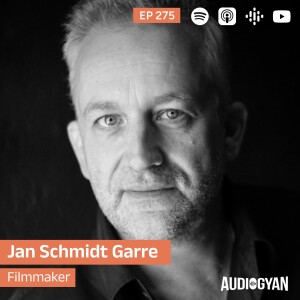
Wednesday Jul 26, 2023
Wednesday Jul 26, 2023
“In feature films, the director is God; in documentary films, God is the director.” Alfred Hitchcock.
Welcome to this 2 part series with Jan Schmidt Garre. First part is about “Making a documentary” and second part is his latest Documentary on Late Ar. B.V.Doshi called the “The Promise – Architect BV Doshi”.
Jan Schmidt-Garre founded PARS MEDIA in 1988. It’s a production company for high-quality documentaries and feature films with a focus on classical music, dance, and the fine arts. His films have been broadcasted in over thirty countries.
Questions
How true are things if they are not documented anywhere?
How do you define private and public? (While documenting)
How objective is / should be documentation?
What are the rules or framework or principles while making a documentary? How you keep the purity and innocence of the moment or the story? Avoid colouring from the past and your own judgement?
What qualifies to be documented? How does one start?
Is there a limit to what can be said in audio-visual format or film making?
Can documentaries be dangerous?
What’s more effective for story telling, making believable? when you witnessing and being part of the documentary or dramatising sections which you couldn’t be a part of?
What are the top 3 attributes of a good documentary?
(Personal) Since your documentaries are on Art, Music and dance, don’t you feel that you are missing out on actual moments of witnessing the event as oppose to filming it?
We’ll continue this topic in part 2 since I wish to talk about film, The Promise, B.V. Doshi
Reference links
https://www.parsmedia.com
https://www.rottentomatoes.com/celebrity/jan_schmidtgarre
https://www.instagram.com/janschmidtgarre/
https://www.delage-artists.com/en/artist/jan-schmidt-garre/biography/
https://www.imdb.com/name/nm0773272/
https://en.wikipedia.org/wiki/Jan_Schmidt-Garre

Your Title
This is the description area. You can write an introduction or add anything you want to tell your audience. This can help potential listeners better understand and become interested in your podcast. Think about what will motivate them to hit the play button. What is your podcast about? What makes it unique? This is your chance to introduce your podcast and grab their attention.








